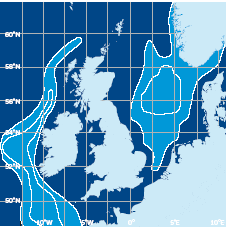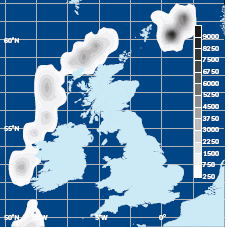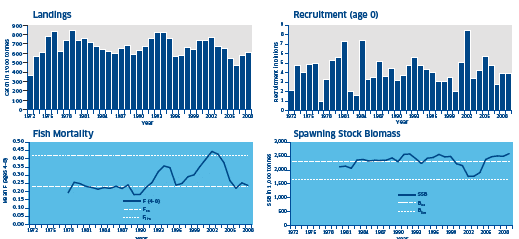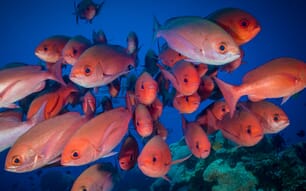Introduction

The bulk of the catch is taken by pelagic trawlers. each year, the number of mackerel in the sea depends on the number of young fish which survive from spawning to enter the adult fishery as recruits. The large annual change in the number of recruits is one reason for managing this stock.
Biology
The mackerel (Scomber scombrus) caught by the Scottish pelagic fleet belong to two different stocks — the North Sea and the western. This separation is based on differences in the timing and the areas used for spawning. North Sea mackerel overwinter in the deep water, to the east and north of Shetland and on the edge of the Norwegian deep.
In the springtime, they migrate south to spawn in the central part of the North Sea from May until July. The western mackerel stock is found near to the continental slope, over a vast area. These fish spawn between March and July, mainly to the south and west of the uk and Ireland. when spawning is finished, most of

The spent fish move to the feeding grounds in the Norwegian Sea and the northern North Sea where they mix with the North Sea stock. Some western stock mackerel, predominantly small individuals, also enter the North Sea through the english Channel.
The western stock mackerel travel long distances between the feeding grounds and the spawning areas. over the past twenty years, the pattern of their southerly migration has changed dramatically in both timing and route. In the 1970s and 1980s this movement occurred in late summer and autumn with the fish passing through the relatively shallow waters of the Minch. Now the migration occurs gradually later in the year and is further offshore. The pattern of the return northerly journey, after spawning, has remained relatively constant. The boundaries of the spawning areas have also slowly changed, with an increase in spawning activity in the north of the area and to the west of the shelf edge.

By the time they reach three years old, most mackerel are mature. At one year old, only a small proportion of females are mature and able to spawn, while more than half can spawn at two years old. female mackerel shed their eggs in about twenty separate batches over the course of a spawning season. An average-sized fish produces around 250,000 eggs. Juvenile mackerel grow quickly and can reach 22cm after one year and 30cm after two years.
The diet of mackerel can vary with the area and the season. By weight, almost half of the food consists of crustacea (shrimps). The remainder is made up of juvenile fish such as sandeel, herring and Norway pout.
ICES Advise on Management

Summary
- Coastal States management plan comes into effect in 2010
- Spawning stock biomass estimated to be above Bpa
- Insufficient data to estimate 2007 and 2008 year-classes
Precautionary approach reference points
For Northeast Atlantic mackerel, ICeS has proposed that the precautionary level for stock biomass (Bpa) be set at 2.3 million tonnes and that the precautionary level for fishing mortality (Fpa) be set at 0.23. The limit reference point for spawning stock biomass (Blim) has been set at 1.67 million tonnes, and the limit reference point for fishing mortality (Flim) is 0.42.
Bpa unchanged since 1998; target reference points added in 1999; Fpa, Flim, and Blim revised in 2008 to address a Coastal States request.
State of stock
Based on the most recent estimate of spawning stock biomass (in 2009), ICES classifies this stock as having full reproductive capacity. Based on the most recent estimates of fishing mortality (in 2008), ICES classifies the stock as being harvested at increased risk.
Fishing mortality in 2008 is estimated to be just above Fpa. SSB has increased by 47 per cent since 2002 and is currently estimated to be above Bpa. The 2002 year class is the highest on record. Subsequent year classes are estimated to be about average. There is insufficient information to confirm the sizes of the 2007 and 2008 year classes.
Management advice
In october 2008 a management plan for mackerel in the Northeast Atlantic was agreed upon by Norway, the Faroe Islands and the EU. The plan would restrict fishing for mackerel on the basis of a TAC consistent with a fishing mortality in the range of 0.20-0.22 with restriction on change in TAC of less than 20 per cent per year, provided the spawning stock biomass remains above 2.2 million tonnes. If SSB falls below 2.2 million tonnes, a TAC is fixed according to expected landings when fishing the stock at a fishing mortality rate determined by the following:
Fishing mortality F = 0.22 x SSB ÷ 2,200,000
In the event that SSB falls below Blim, a TAC may be decided upon by a fishing mortality rate that will be less than one determined by the above formula. ICES concluded that the management plan is precautionary, assuming that the TAC equals the total removals from the stock.
for 2010 ICeS advises a 5-13 per cent decrease in TAC. This is in line with fishing mortality rates set out in the management plan (F between 0.20 and 0.22) and implies catches between 527,000 and 572,000 tonnes. The SSB is expected to remain stable in 2011 for a catch in this range.
Catches in 2007 and 2008 have been considerably in excess of the ICES advice. The absence of effective international agreements on the exploitation of the stock (between all nations involved in the fishery) is a cause of concern and prevents control of the exploitation rate of the stock.
According to the short-term forecast, the total estimated catch in 2009 results in an estimated fishing mortality of 0.31, which is above that stipulated in the management plan (it should be noted that this F would be lower without the significant additional catches in excess of the TAC).
The 2010 TAC advice given above should apply to all areas fished. Mackerel is mainly exploited in a directed fishery for human consumption. This fishery tends to target bigger fish and there is evidence that this causes discarding of smaller, less marketable fish.
In June 2009, an agreement was concluded between contracting parties to the Coastal States on mackerel banning high-grading, discarding, and slipping from pelagic fisheries targeting mackerel, horse mackerel, and herring beginning in January 2010.
Management action
At the december 2009 meeting in Brussels, the Council of Ministers decided that the eu Total Allowable Catch for northeast Atlantic mackerel should be 317,748 tonnes. The uk quota was set at 173,663 tonnes.
April 2010

